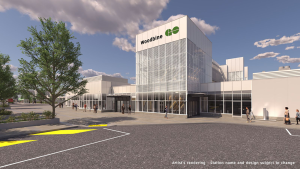Project delivery is one of the most complex issues facing the construction industry in Alberta.
It can also be the source of friction and adversarial relationships between the parties involved.
In an effort to clarify roles and responsibilities, expectations and communication, a panel of experts offered their insights into project delivery methods at the recent inaugural, OAEC (Owners, Architects, Engineers and Contractors) Conference hosted by the Calgary Construction Association and held at the BMO Centre.
The four methods that were examined included design-bid-build (DBB), construction management (CM), design build and Public-Private Partnerships (P3s).
DBB is a popular delivery method, according to Brian Soutar, with Alberta Infrastructure, Project Service Branch.
“Seventy-one per cent of our contracts this fiscal year are design-bid-build. Out of our $8.2 billion budget, nine per cent of those dollars are design-bid-build,” he said.
In this delivery process, Alberta Infrastructure expects the prime consultant to do what he or she said they’d do, Soutar explained to a crowd of conference attendees.
“We expect the design by the architect will be according to schedule and budget, we also expect the tender documents will be clear and well co-ordinated.”
But that would be in an ideal situation, and often common issues crop up, he said.
“The promises consultants make about how amazingly they’ll do the project are frequently over-promised and under-delivered,” he added.
“We frequently see designs that take way too long with not enough adherence to the importance of schedule. We frequently see tender documents that are improperly formatted and poorly co-ordinated.”
Craig Webber, principal with Group2 Architecture Interior Design Ltd., said that the design-bid-build process often sees his team asked to do more work over the same timeframe.
“Over the last 10 years, I’ve seen the industry change in terms of expectations and requirements that are being asked, and these are good things, they add value to projects,” he said.
“But what I haven’t seen necessarily is the expansion of the project delivery timeframe that responds to and accommodates some of those things.”
From a contractor’s point of view, there’s a lot less collaboration between parties, said Serge Massicotte, president of Massicotte Construction Ltd.
He suggested with this particular delivery method, there was a disconnect between owner and contractor.
“We all want to have a successful project, we want an owner that’s happy and a design team or consultant that’s happy as well, but we have huge expectations which aren’t being met, with regards to quality of documents, fair allocation of risk in contracts,” he said.
“There’s a lot of risk being shipped off on contractors that we can’t manage, and sometimes in downloading it to sub-contractors, that creates a huge adversarial process in design-bid-build.”
Eighty per cent of Alberta Infrastructure’s $8.2 billion budget is devoted to the construction management delivery method, Soutar said, adding that it was only 15 per cent of the projects in total.
“We use construction management on complex projects, often projects that might be major renovations that already have people in it, for example, operating as a hospital,” he explained, adding that the delivery method is used on fast-tracked projects.
Well-executed and applied CM delivery saves time and allows for increased collaboration with designers, consultants and contractors.
Massicotte agreed, adding that it’s a more intense delivery method, but has benefits.
“A lot more work involved, absolutely,” he said.
“I would say the upfront cost is more. Every CM project we’ve worked on has cost more than if we’d done DBB, however, I think you get a better quality project, completed quicker, with fewer deficiencies and happier customers. I think that’s the real benefit of CM.”
In CM, communication is key to making the process work, Webber added.
Managing that communication flow is critical to this type of delivery process.
“If done well, it can be a real benefit when doing some complex projects without major cost overruns,” he said.
The design-build delivery method accounts for five per cent of Alberta Infrastructure’s projects, which represents seven per cent of the overall budget, Soutar said.
He explained that Alberta Infrastructure uses design-build to fast-track projects, where they can clearly define requirements and apply innovation.
“We expect the design-build team will perform at high levels of innovation in construction and design,” Soutar said.
“We expect the team will be competent, professional and well-organized.”
The panel briefly touched on P3 project delivery methods.
“We think of it as design-build with a 30-year warranty,” Soutar said.
“From our perspective, we like P3s, where appropriate.”
The risk to contractors, architects and engineering firms with P3s can be real, and devastating if not handled properly, two of the experts told the crowd.
Companies were advised to research thoroughly before getting involved in P3 projects.
“The risk with P3s is extremely large and if you aren’t successful, the extra consequences can be quite devastating financially,” Webber said.










Recent Comments
comments for this post are closed